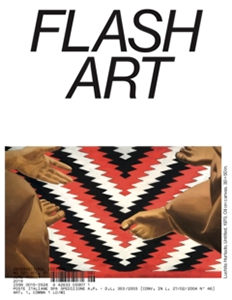The articles and interviews included in this issue of
Flash Art address the human body, introducing artistic practices that push the body's physical boundaries and challenge its codified representations. With Luchita Hurtado; special feature on artist, educator, curator, and cultural theorist Ian White; Lena Henke;
Martti Kalliala on the transformational experience of Burning Man; Eric N. Mack; Stefano Sollima; Bruce Nauman by
Isabelle Graw (on
Flash Art March-April 1993); exhibitions reviews.
In the paintings of Venezuelan-born, California-based Luchita Hurtado, this issue's cover artist, the body becomes a landscape or is self-portrayed from the artist's own perspective, with no mirrors or cameras to aid her, as a way to connect the personal with the contextual. “[Hurtado's] body multiplies and moves from confined domestic spaces into public, wide-open spaces, acting as a sincere pre-selfie browser that brings its vulnerability with it everywhere,” writes Catherine Wagley in her article on the artist.
Also contained in this issue is a twelve-page dossier dedicated to artist, educator, curator, and cultural theorist Ian White, who died of cancer in 2013 at the age of forty-two. Compiled on the occasion of the Camden Arts Centre's current overview of White's output, the dossier reconsiders White's critical strategies, all of which engage the body as a site of inquiry for examining the historical and political conditions for making and presenting art. According to Federico Florian, who along with Emma Hedditch and Matt Wolf contributed to the dossier, White saw “movement in all of its connotations—relating to the performing body, the muscle-mind, and that of the encroaching illness—[as] a constant concern. As if thinking and talking about gestures, about motion, was a way to stay active and critically receptive.”
Flash Art is a contemporary art and culture magazine founded in 1967. Within a decade, it became an indispensable point of reference for artists, critics, collectors, galleries, and institutions. In 2020, Flash Art became a quarterly publication, at the same time increasing its trim size and updating its graphic identity. The magazine offers a fresh perspective on the visual arts, covering a range of transdisciplinary approaches and fostering in-depth analyses of artist practices and new cultural directions. Today, Flash Art remains required reading for all who navigate the international art scene.
Flash Art is known for it covers featuring artists who subsequently become leading figures in the art world. The magazine includes photoshoots, productions, critical essays, monographic profiles, conversations with emerging and established artists, and a range of ongoing and thematic columns that change every few years. The long history of the magazine is also highlighted by pivotal texts from the archive that are included in the publication time to time. Finally, every issue offers a highly curated selection of the best institutional exhibitions on the global scene.

